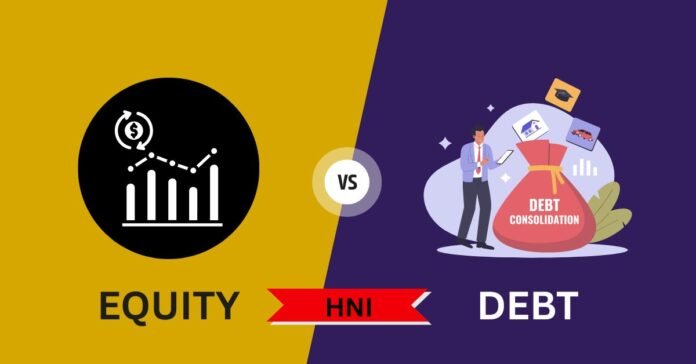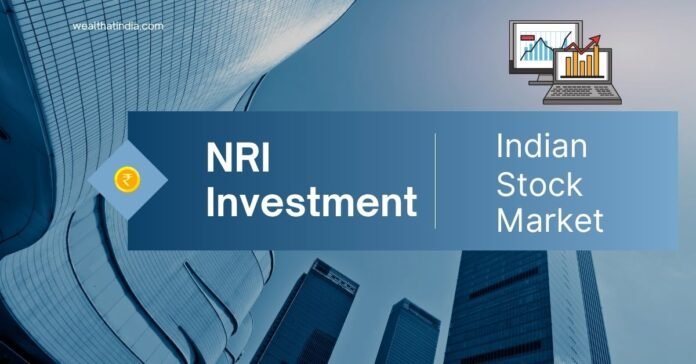India’s High Net-worth Individuals (HNIs) have become the driving force behind the country’s wealth management and private investment ecosystem. With rising disposable incomes, growing global exposure, and an increasing appetite for sophisticated financial instruments, HNIs today face one fundamental question: Should they invest more in equity or in debt?
This decision is not as simple as choosing between high risk and safety. For HNIs, the Equity vs Debt for HNIs debate is about capital preservation versus growth, market timing versus consistency, and wealth creation versus wealth protection. The choice defines not just their short-term portfolio returns but also their long-term financial legacy.
This article dives deep into the Indian context exploring how equity and debt investments perform for HNIs, the ideal portfolio mix, tax implications, and how wealthy investors can align both asset classes for maximum efficiency. By the end, you’ll have a clear understanding of how to balance equity and debt intelligently as an HNI in India.
Understanding the Investment Landscape for HNIs in India
HNIs in India typically have investable assets of over ₹5 crore. Their financial goals often differ from those of regular investors. While middle-class investors focus on saving for retirement, education, or housing, HNIs prioritize wealth preservation, inter-generational transfers, tax optimization, and global diversification.
Their portfolio construction approach is more strategic than reactive. They engage with portfolio management services (PMS), alternative investment funds (AIFs), private equity opportunities, structured products, and global equities. Yet, despite this access to sophisticated products, the foundational question remains: how much should be allocated to equity and how much to debt?
To answer that, one must first understand what each asset class represents and how each aligns with an HNI’s unique risk-reward profile.
Read- HNI Balanced Portfolio: Smart Strategies for Wealth Growth in India
What is Equity?
Equity represents ownership in a company. When you invest in equity — whether directly through shares or indirectly through equity mutual funds, PMS, or AIFs — you own a portion of the business and participate in its growth. The value of your investment depends on how well the company performs and how the market values it over time.
For HNIs, equity is not just an asset class; it’s a growth engine. Over the long term, equities have historically delivered superior returns compared to most other asset classes. Between 2013 and 2023, the Nifty 50 index delivered a compounded annual growth rate (CAGR) of around 11% — despite volatility and market corrections. Top-tier PMS and AIF strategies have even outperformed this benchmark.
Equity provides exposure to India’s structural growth story a young demographic, rising consumption, expanding credit, and digital transformation. For HNIs seeking to multiply wealth and create long-term legacies, equity remains indispensable.
However, the same volatility that offers opportunity also brings risk. Market downturns, policy changes, or global shocks can temporarily erode portfolio value. Hence, equity is best suited for long term wealth creation, not short-term liquidity needs.
What is Debt?
Debt investments involve lending money to an institution (like a company or government) in exchange for interest payments and the return of principal at maturity. Common examples include corporate bonds, government securities, fixed deposits, and debt mutual funds.
For HNIs, debt serves as a stabilizer. It adds predictability and cushions portfolios against equity market fluctuations. High-rated corporate bonds or debt AIFs can offer steady post-tax returns in the range of 7% to 9% — a meaningful component of overall wealth management when liquidity and capital safety are priorities.
HNIs also use debt instruments for cash flow management, short-term parking, or strategic allocation during volatile equity cycles. Because debt instruments behave inversely to interest rate movements, they can also be used tactically when the Reserve Bank of India (RBI) begins an easing cycle.
Read- Top Mistakes HNIs Make in Wealth Management
Why the Equity vs Debt Decision Matters More for HNIs
For average investors, asset allocation is often a formula-driven decision. But for HNIs, it’s deeply personal and strategic. They are not merely seeking returns — they are managing risk across generations. Their investments fund business expansions, philanthropy, real estate purchases, and family trusts.
This makes the equity vs debt balance vital. Too much equity exposure can cause short-term volatility, affecting liquidity and estate planning. Too much debt, on the other hand, may reduce long-term growth potential and fail to outpace inflation.
An HNI’s portfolio must be designed around four principles:
- Capital Preservation: Safeguard wealth against market shocks.
- Capital Growth: Generate inflation-beating, compounding returns.
- Tax Efficiency: Maximize post-tax wealth creation.
- Liquidity: Maintain access to funds without disrupting strategy.
Striking the right equity-debt ratio ensures that all four goals coexist harmoniously.
Equity for HNIs: When and Why It Works Best
Equity investments are best suited for HNIs who seek to grow their wealth exponentially over time. Because they typically have a longer investment horizon and higher risk capacity, HNIs can afford to weather market volatility.
Key Benefits of Equity for HNIs:
- Wealth Compounding: Over long periods, equities tend to outperform most other asset classes. A ₹1 crore investment in diversified equity 10 years ago could easily have grown to over ₹2.8 crore, while debt would have offered limited compounding.
- Inflation-Beating Returns: Equity returns have historically exceeded inflation rates, ensuring real wealth growth.
- Participation in India’s Growth Story: As India moves toward becoming a $5 trillion economy, equities allow direct participation in corporate and economic expansion.
- Access to Advanced Instruments: HNIs can access PMS, AIFs, global equity funds, and pre-IPO investments — avenues that amplify potential returns.
- Legacy Building: Equity investments, when structured through family trusts or holding companies, can form the cornerstone of intergenerational wealth transfer.
However, equity requires patience, discipline, and professional management. Without these, even wealthy investors can fall prey to emotional decisions and timing errors.
Debt for HNIs: The Role of Stability and Capital Protection
Debt is often misunderstood as a conservative asset class, but for HNIs, it serves critical strategic purposes. It provides stability to the portfolio, acts as a liquidity reserve, and generates consistent income during uncertain times.
Key Advantages of Debt for HNIs:
- Capital Preservation: High-quality bonds or debt mutual funds ensure safety of capital even during equity market downturns.
- Stable Income Stream: Regular interest payouts from bonds or structured debt instruments create predictable cash flow.
- Risk Diversification: Debt reduces portfolio volatility, balancing equity exposure.
- Tax Efficiency: Certain debt funds and bonds qualify for indexation benefits or tax-free interest.
- Liquidity and Flexibility: Short-duration debt funds allow HNIs to manage short-term cash requirements effectively.
HNIs also leverage structured credit, real estate debt, and private lending opportunities through AIFs to enhance returns beyond traditional bonds, without taking full equity-like risk.
Balancing Equity and Debt: The Ideal Portfolio Mix for HNIs
There’s no universal formula, but experience and data suggest that HNIs should maintain a diversified, dynamic asset allocation. A 60:40 or 70:30 mix between equity and debt often works well — adjusted periodically based on market conditions, age, and personal goals.
For example:
- Aggressive HNIs (Below 45 years): 70–80% equity, 20–30% debt.
- Balanced HNIs (45–60 years): 60% equity, 40% debt.
- Conservative HNIs (Above 60 years): 50% or less equity, 50% or more debt.
The objective isn’t just return maximization but risk optimization. Debt acts as a cushion when equities underperform and provides capital for opportunistic re-entry during corrections.
Many professional wealth managers in India adopt tactical rebalancing strategies — increasing equity exposure when valuations are attractive and shifting towards debt during overheated market phases.
The Role of Professional Wealth Management
HNIs in India often rely on professional portfolio managers for managing equity and debt allocation. PMS and AIF providers design bespoke strategies aligned with the client’s goals, liquidity requirements, and tax preferences.
For equity: They may use factor-based strategies, mid-cap or multi-cap allocations, and global equity exposure.
For debt: They focus on high-yield corporate debt, sovereign bonds, and structured products with credit enhancement mechanisms.
These professionals also assist with portfolio rebalancing, tax planning, and risk management — ensuring that returns are optimized without compromising safety.
Tax Implications: Equity vs Debt for HNIs
Taxation is a decisive factor for HNIs, especially those in the highest tax bracket.
For Equity:
- Short-term capital gains (STCG) on listed equities (held < 1 year) are taxed at 20%.
- Long-term capital gains (LTCG) beyond ₹1.25 lakh (for holdings > 1 year) are taxed at 12.5% without indexation.
- Dividends are added to income and taxed at the investor’s slab rate.
For Debt:
- Interest income is taxed as per the individual’s slab rate.
- Debt mutual funds are now taxed like fixed deposits after 2023’s taxation reform — gains are treated as short-term and taxed at the investor’s slab rate.
- However, structured debt AIFs and tax-free bonds can help reduce effective taxation.
Efficient tax structuring through family offices, trusts, and offshore entities (where applicable) helps HNIs enhance post-tax returns while remaining compliant.
Read- Strategic Asset Allocation for Ultra-Wealthy Investors (Building Wealth Beyond Generations)
Market Outlook: Equity and Debt in 2025 and Beyond
As of 2025, India’s financial markets are in a phase of transformation. Equity valuations remain elevated but justified by robust earnings growth and strong domestic liquidity. Sectors like financial services, infrastructure, manufacturing, and renewable energy offer strong long-term prospects.
Debt markets are equally attractive, with interest rates expected to stabilize as inflation moderates. Government securities and high-quality corporate bonds are offering yields between 7% and 8.5% — compelling for conservative allocations.
For HNIs, this environment reinforces the need for balanced diversification. Allocating new capital in a phased manner through systematic transfer plans (STPs) from debt to equity can help average out entry costs while maintaining liquidity.
Global Diversification for Indian HNIs
Wealthy Indian investors are increasingly exploring offshore investments through Liberalised Remittance Scheme (LRS) routes. Equity exposure to global markets — especially U.S. tech, European ETFs, and Asian funds — provides diversification against domestic market volatility.
Similarly, debt exposure to international bonds or global fixed-income funds can hedge currency and geopolitical risks. However, regulatory considerations and taxation under FEMA and RBI guidelines must be managed with professional advice.
Risk Management and Liquidity Strategy
While equity delivers growth, and debt provides stability, liquidity ensures resilience. HNIs must always maintain 10–15% of their net worth in highly liquid instruments like short-term debt funds, overnight funds, or treasury bills.
This liquidity acts as an emergency reserve and enables tactical opportunities during market corrections. A disciplined rebalancing framework — reviewing allocations quarterly or semi-annually — prevents emotional decision-making and aligns portfolios with market dynamics.
Building a Legacy with Balanced Investments
For HNIs, investing is not merely about maximizing returns; it’s about creating sustainable wealth across generations. Balancing equity and debt ensures that the next generation inherits both growth and security.
By combining aggressive equity positions for long-term compounding with conservative debt holdings for preservation, HNIs can establish family trusts, charitable foundations, and succession frameworks that endure market cycles.
The most successful Indian HNIs — from business families to professionals — follow one rule consistently: Don’t chase short-term trends; balance your risk across time horizons.
Conclusion
For Indian HNIs, the debate between equity and debt is not a choice — it’s a calibration. Both asset classes are essential, and their power lies in proportion, not exclusion.
Equity builds wealth through ownership and compounding. Debt protects wealth through stability and income. Together, they form the backbone of a resilient portfolio.
In an era of rapid economic expansion, rising interest rate shifts, and global uncertainties, the smartest HNIs are not those who take the biggest bets but those who build balanced, adaptive, and tax-efficient portfolios. The future of wealth management in India belongs to investors who treat equity and debt not as rivals but as allies in their journey toward financial independence and legacy creation.
FAQ
Q1: What is the ideal ratio of equity and debt for HNIs in India?
The ideal equity-debt ratio for HNIs depends on age, goals, and risk appetite. Generally, younger HNIs (under 45) prefer a 70:30 or 80:20 mix in favor of equity, while older investors (above 55) may shift to a 60:40 or 50:50 balance. The key is periodic rebalancing based on market conditions and personal financial objectives.
Q2: Why is equity important in an HNI’s portfolio?
Equity is essential for long-term wealth creation because it offers high compounding potential, inflation-beating returns, and participation in India’s economic growth. For HNIs, equity exposure through PMS, AIFs, or global funds helps multiply wealth and build a lasting financial legacy.
Q3: How does debt help HNIs manage portfolio risk?
Debt investments provide stability and protect capital during market volatility. They offer predictable returns and liquidity, making them ideal for balancing equity exposure. Instruments like high-rated corporate bonds, debt AIFs, or tax-free bonds help HNIs manage risk without sacrificing steady income.
Q4: Are equity returns better than debt returns for HNIs in the long run?
Yes, historically, equity has outperformed debt in the long term. Over a 10-year horizon, equity markets in India have delivered 10–12% CAGR, while debt instruments typically yield 6–8%. However, equity returns come with higher volatility, so maintaining a balanced mix ensures smoother performance and capital safety.
Q5: What tax factors should HNIs consider while investing in equity and debt?
Equity gains are taxed at 15% for short-term holdings (less than one year) and 10% beyond ₹1 lakh for long-term holdings. Debt income, including interest and short-term gains, is taxed at the investor’s slab rate. HNIs can reduce their tax burden by investing in tax-free bonds, structured debt AIFs, and optimizing equity holding periods for favorable capital gains treatment.
Disclaimer
This article is for educational and informational purposes only. It does not constitute financial, investment, or tax advice. Readers are advised to consult certified financial advisors or wealth managers before making investment decisions. The author and publisher are not responsible for any losses arising from the use of information provided in this content.










